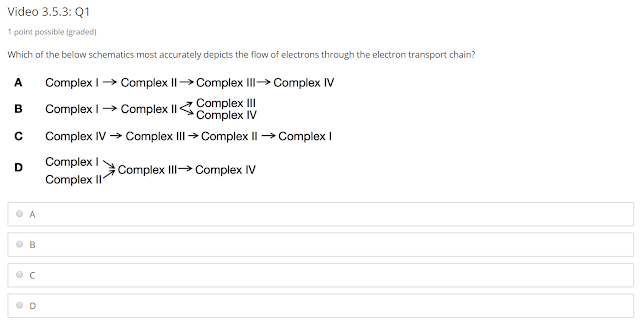It means the reaction has a negative free energy - which means the reaction is spontaneous.
The reaction under question is the first reaction goes in reverse and the second reaction goes in forward, therefore, the $ \Delta E^{t_0} = 0.220 - 0.077 = 0.143 $.
The free energy can be computed using $ \Delta G = -nFE = -1 \times 96.5 \times 0.143 = -13.7995 $
A negative free energy indicates the reaction is spontaneous.
Oxidation is Loss - Reduction is Gain (OIL RIG)
During the first electron transfer, the first electron donor is oxidized and the second electron donor is reduced, therefore, the reaction has a reduction potential given by $ \Delta E = E_2 - E_1 $, where $ E_1 $ is the reduction potential of the first electron donor and $ E_2 $ is the reduction potential of the second electron donor.
In order for these reaction to be spontaneous, these reduction potential must be all positive, in other words, $ E_1 < E_2 $.
Therefore, the correct answer is:
Sort them according to their physiological reduction potential (E), lowest to highest.
We have already outlined the theoretical approach in the previous problem, basically, order them according to the reduction potential (the standard condition here is irrelevant, what is relevant is the condition in the cell).
An experimental approach would be to disrupt some known steps in the electron transport chain. If the chain is disrupted, then there wouldn't be consumption of oxygen or production of ATP, but definitely we should still see changes in oxidation states.
Therefore the correct answers are:
Rank the electron carriers in terms of their reduction potential ($ \Delta E $), and
Treat the cells with drugs to disrupt known steps in the electron transport chain and observe the oxidation state of each electron acceptor/donor.
This is fully oxidized Coenzyme-Q (also known as Q or ubiquinone).
The -one prefix reminds me about the ketone, with the two double bond O pointing outward, in reduced state, these ketone group are reduced into hydroxyl group.
It is obviously not a coenzyme Q.
It is not an iron-sulfur center as there is no sulfur.
The only sensible answer is that is a a heme.
Therefore the answer is
A heme functional group, the redox component of the cytochromes.
















































